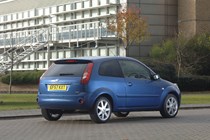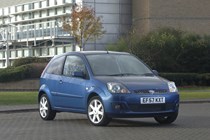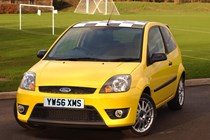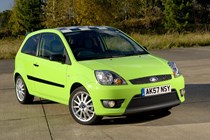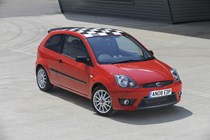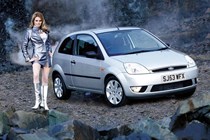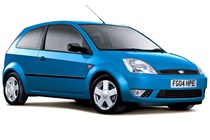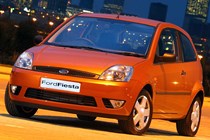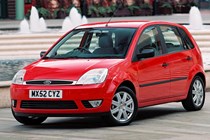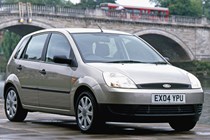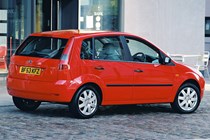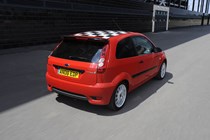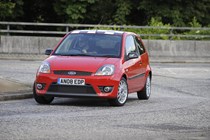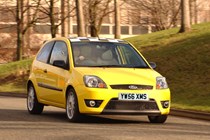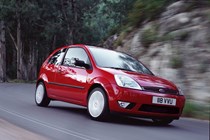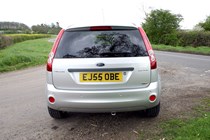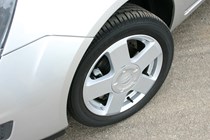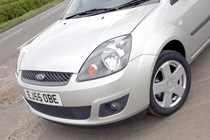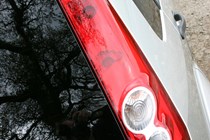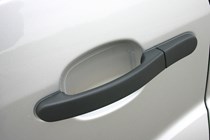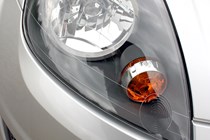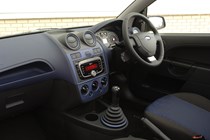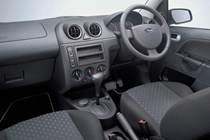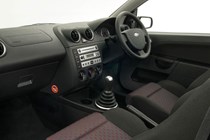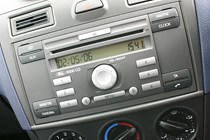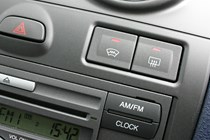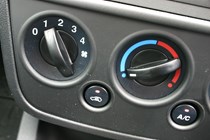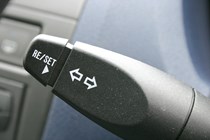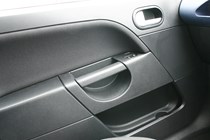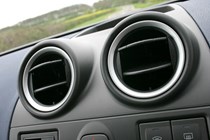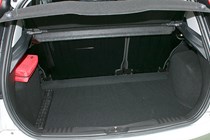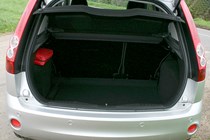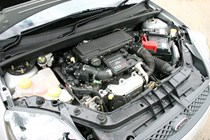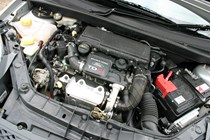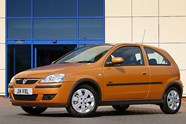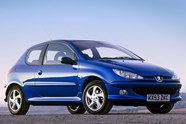Ford Fiesta Hatchback (2002-2008) review
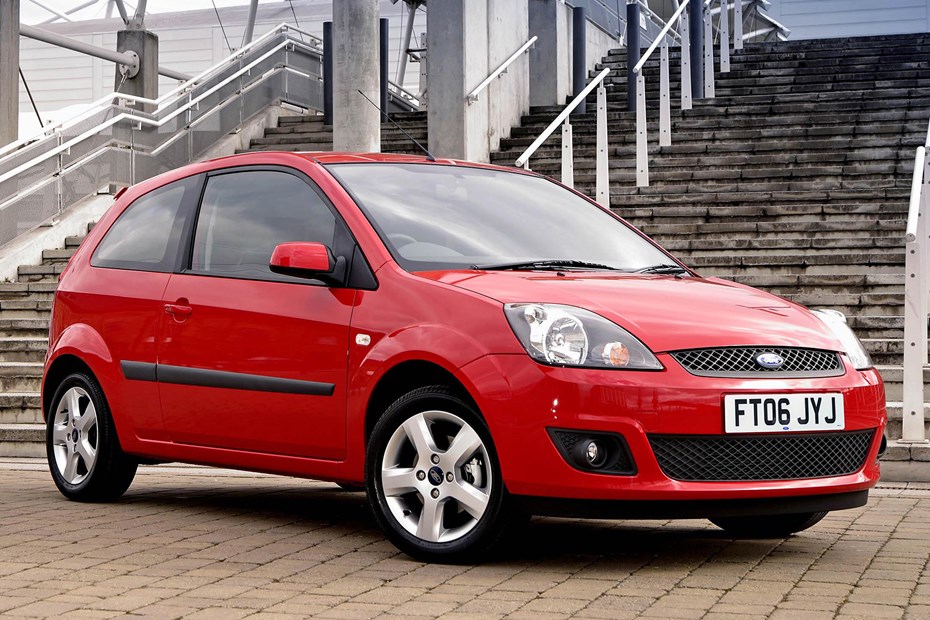
At a glance
| Price new | £8,090 - £14,516 |
|---|---|
| Used prices | £455 - £2,759 |
| Road tax cost | £35 - £345 |
| Insurance group | 5 - 28 |
Get an insurance quote with

|
|
| Fuel economy | Not tested to latest standards |
| Range | 366 - 643 miles |
| Number of doors | 3 - 5 |
| View full specs for a specific version | |
Available fuel types
Petrol
Diesel
Pros & cons
- Easy to drive
- Room for four adults
- Lively engines
- Dull interior
- Not enough luggage space for four adults
- Lots of niggling issues
Ford Fiesta (02-08) rivals
Overview
Launched in 2002, the fifth-generation Ford Fiesta was a much bolder evolution than the previous model. It also marked the end of car production at Dagenham in Essex with this all new vehicle now being assembled in the Spanish city of Valencia – Ford’s lead plant for small cars.
A great deal of the mechanicals carried over from the Mk4, but attention was paid to build quality, interior trim and general refinement. The Ford marketing machine got its figures pretty much spot on with the car being an instant success from initial launch. This version had a six-year run of production where a sprinkling of nips, tucks and a minor facelift kept the Fiesta fresh looking and competitive insofar as pricing mattered.
There was a vast trim level range, a plethora of engine/gearbox options and aggressive array of finance options to keep the car in the prospective customers minds-eye and high in the sales chart Top 10.
Ford Fiesta Mk5 known faults and common problems
1. TIRED ENGINES
Early 1.3 cars used the ancient crossflow pushrod Valencia unit. These old units by now generally rattle and tap like a box of broken crockery but are nigh-on unburstable. Also note the Zetec petrol units will not tolerate ignored servicing for too long. If allowed to run low on oil they shred their bottom end bearings. Listen for a rumbling or deep noted clatter when on idle.
2. BENT OR BROKEN STEERING RACKS
It has been noted that cars driven over deep potholes at low speed or launched up onto high kerbs can easily bend the steering rack arms and at worst, break a tooth off the pinion. Check for wayward urban handling and/or a clunk or knock noise as you spool the wheel from full left to full right when stationary.
3. SMOKING DIESELS
The thrifty 1.4TDCi engine is known for oil consumption when they have rattled a few miles off. Check the dipstick for correct level and be extra aware if the oil looks clean if it’s in between servicing intervals. This tells you its regularly being topped up. Also – keep an open eye for one litre top-up bottles decorating the boot or in the vendors garage if a private sale.
4. NOISY GEARBOXES
Manual cars can suffer from driveshaft seals going hard and leaking transmission oil onto the floor. It doesn’t take too much leakage before it sacrifices the differential bearings and the gearbox main shaft bearings. If the gearbox ‘chatters’ when idling in neutral or you can hear a humming noise when sharp turning or when on a roundabout the gearbox is ruined.
5. INCONSISTENT IDLING
Zetec petrol engines can be known for idling problems that some back street garages still seem to struggle to cure. In many cases it requires little more than a new ICV (idle control valve) and a system reboot via the diagnostic port with some Ford software.
6. COOLANT LEAKS
Leaking water pumps on petrol cars seems to be the current trend on these cars. However, also have a look where the coolant pipes go into the bulkhead to supply the heater for signs of dribbling. The plastic heater blend valve can age-weaken and crack causing either the temperature to refuse to be altered or at worst, the stub pipes to shear off causing instant full coolant loss. Caught in time though it’s a cheap and easy fix – plus a good bartering point.
7. NON-WORKING REAR WASH-WIPER
This could be nothing more than a burnt-out motor (a blown fuse will confirm) but on an older car like this, could be a broken wiring harness. Have a look where the loom feeds from the body into the tailgate for signs of previous attention like insulating tape. An auto electrician can easily fix this but its fiddly to make good again and not recommended DIY wise unless you are skilled and confident.
8. GENERAL BODY CONDITION
Pay close attention to the edges of the wheel arches, inside the filler cap area and along the body sills for rust. If corrosion if evident here it may well be taking hold in more worrying areas like floor pan joints and seatbelt strengthening plates and the front subframe. Anything showing serious rust just isn’t worth buying – even at scrap value. Urban toreador cars will also show signs of poor repair damage and wonky paintwork.
9. CLONKING FRONT SUSPENSION
Keep a look out for broken or badly rusting front coil springs and listen for thumping noises signalling worn bottom ball joints. If the car gives off a faint pattering sound when running over smooth roads you may need to budget for a pair of anti-roll bar drop links. Thankfully all the aforementioned are easy to fix and parts are cheap to buy.
10. ELECTRICAL GREMLINS
Ensure everything works as it should and test out the charging system if the car has a heated windscreen. If the interior light pulsates or faintly flickers on idle with the heated screen and dipped beam switched on, you may be looking at an earth cable fault or the alternator showing early signs of its death.
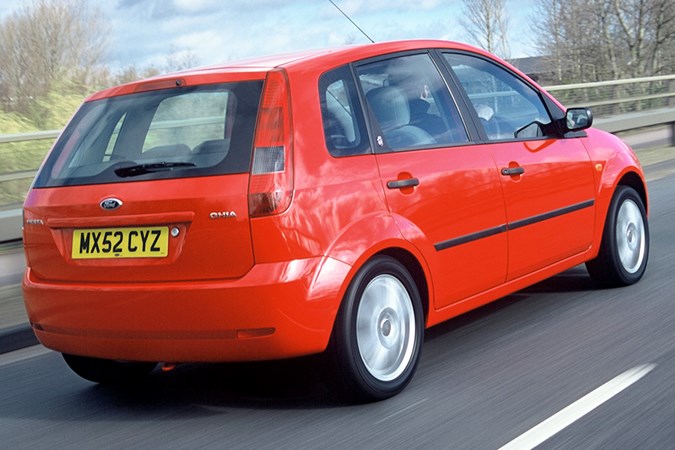
Today, the Ford Fiesta Mk5 offers little more than a distress-led purchase owing to the car’s age. However, as a first car or an inner-city runabout that you’re not going to worry about if it loses the odd door mirror or picks up a minor dent here and there, a decent Fiesta could well top the bill. Generally, they are idiot proof and easy to own, but beware of some truly knackered wrecks out there too.
Skip to our verdict page to see if we recommend the Ford Fiesta Mk5 as a good used car.



